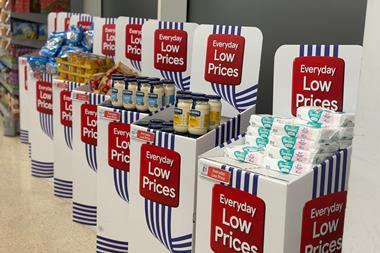It's not just mortgages that shoppers can buy from the supermarket multiples these days. They can also buy homes. The last few months have seen a rash of residential development from the supermarkets as they try to sweeten their planning applications for town centre stores with the promise of a substantial housing element.
Residential development is expensive, onerous, and hardly a core remit of a supermarket. But as local authorities move to increase their housing stock to tackle housing shortages, mixed-use developments look set to become the norm. So what does the government expect and how are the multiples delivering?
London Mayor Ken Livingstone provoked huge controversy in the property world when he called for up to 50% social housing in new commercial developments in his London Plan a figure he subsequently cut to 30%. He thinks a minimum of 23,000 new homes need to be built annually to solve London's housing crisis which he says is undermining its economy.
The rationale for the local authorities and housing bodies is obvious. As far as Paul Pearce, head of regeneration at Notting Hill Housing Group, is concerned, "exploiting the potential of building housing on either new or existing supermarket sites could significantly add to the housing supply in London".
He adds that supermarkets provide sites for housing that might not otherwise be available while creating jobs for the local residents.
Residential developments can take on a number of guises from building houses on the fringe of surplus car parking space on large suburban sites to building flats above single-storey urban stores.
Each of the major players is taking a slightly different tack some electing to work in a joint venture with a housebuilding or property developer partner, some preferring to go it alone and some doing a bit of both.
Tesco has taken the bull firmly by the horns. It has plans to build between 3,000 and 4,000 new homes over the next five years and has completed mixed residential and store schemes in Earls Court and Hammersmith, which provide nearly 200 low- cost homes managed in partnership with registered social landlords Peabody Trust and the Notting Hill Housing Group respectively.
According to Tesco's corporate affairs manager Katherine Edwards, for every store that is considered for extension, there will also be an examination into the viability of providing housing as part of the scheme.
Tesco has also received consent from Lambeth Council to build a mixed-use regeneration scheme in Streatham that will include a new 38,000 sq ft store and 250 housing units, of which 40% will be affordable homes. And at the former South London Hospital in Clapham, Tesco will build a 25,000 sq ft supermarket and provide 104 flats, 25% of which will be affordable.
In both these cases, Tesco has led the development, only seeking property partners to build and manage the housing once it had secured planning permission. It is also prepared to go it totally alone if necessary and is doing just that with a smaller scheme in Torquay, where it plans to build 22 flats above a new Metro store.
Sainsbury in Pimlico
Meanwhile Sainsbury is nearing completion of a mixed-use scheme in Pimlico, which will include a new 30,000 sq ft supermarket and 154 residential units. It is also incorporating housing at proposed store extension schemes in Forest Hill and Richmond and on an under-utilised car park in Fallowfield, Manchester.
A Sainsbury spokeswoman says its schemes vary. "In mixed use schemes with affordable housing we tend to have agreements in place with the relevant housing association before development commences. These units are in effect pre-sold to the association and constructed to an agreed specification."
Likewise Asda is increasingly undertaking mixed-use schemes, either because an existing landlord wants it to be an anchor retailer in a new development or because it is submitting a planning application for a store that it knows is unlikely to get approval without a residential element. This is the case in Poole, where it has received consent to build a 94,000 sq ft store that incorporates 64 flats for social housing "to reflect the local housing planning policy".
Asda will actually build the flats and lease them to a housing association. To balance the financial equation it will sell part of the site to a housing developer for private housing.
Richard Petyt, senior development surveyor for Asda, says the company is always open to new concepts. "Adding mixed-use schemes to our portfolio is excellent experience for our business and reflects our flexible approach towards store formats," says Petyt.
The big question is whether these schemes stack up financially. As Edwards puts it: "There has to be a commercial equation so that we don't lose out financially, while the store must also be able to operate on a normal basis."
The affordable housing equation is highly complex, agrees Charles Palmer, partner at surveying firm Knight Frank. "There should always be an element of social housing," he says. "However, local authorities and the London Mayor need to keep a balanced figure as an incentive to the developer and to retain the attraction of developing."
Chris Marsh, principal lecturer in planning and development at the University of Westminster, warns that the type of scheme will also influence the financial viability.
"At one extreme, the supermarket can just sell off part of the car park or develop it themselves," he says.
"But at the other extreme there are significant ongoing management costs in looking after housing and the real value to investors is likely to be reduced. From a development and investment perspective there are major cost variations."
For instance, if the development requires decked car parking in order to release part of the site for housing, then costs will rocket, says Marsh. When building above an urban store you must calculate whether you can get enough density on the upper floors to make housing worth the extra structural costs.
Mixed residential and retail developments are here to stay. The Office of the Deputy Prime Minister estimates that 25,000 housing units could be built above single story developments, such as foodstores and petrol stations, over the next 25 years.
Another study, sponsored by Tesco and the Housing Corporation, estimates there is a capacity for 10,000 homes to be built on existing free-standing supermarket sites in London alone.
At the moment, says Clive Fraser, senior regeneration planner at Lambeth Council, provision of housing in supermarket developments is actively encouraged, but not a tacit requirement to gain planning consent. The question the supermarkets must be pondering is: how long before it is?
{{ANALYSIS }}
Residential development is expensive, onerous, and hardly a core remit of a supermarket. But as local authorities move to increase their housing stock to tackle housing shortages, mixed-use developments look set to become the norm. So what does the government expect and how are the multiples delivering?
London Mayor Ken Livingstone provoked huge controversy in the property world when he called for up to 50% social housing in new commercial developments in his London Plan a figure he subsequently cut to 30%. He thinks a minimum of 23,000 new homes need to be built annually to solve London's housing crisis which he says is undermining its economy.
The rationale for the local authorities and housing bodies is obvious. As far as Paul Pearce, head of regeneration at Notting Hill Housing Group, is concerned, "exploiting the potential of building housing on either new or existing supermarket sites could significantly add to the housing supply in London".
He adds that supermarkets provide sites for housing that might not otherwise be available while creating jobs for the local residents.
Residential developments can take on a number of guises from building houses on the fringe of surplus car parking space on large suburban sites to building flats above single-storey urban stores.
Each of the major players is taking a slightly different tack some electing to work in a joint venture with a housebuilding or property developer partner, some preferring to go it alone and some doing a bit of both.
Tesco has taken the bull firmly by the horns. It has plans to build between 3,000 and 4,000 new homes over the next five years and has completed mixed residential and store schemes in Earls Court and Hammersmith, which provide nearly 200 low- cost homes managed in partnership with registered social landlords Peabody Trust and the Notting Hill Housing Group respectively.
According to Tesco's corporate affairs manager Katherine Edwards, for every store that is considered for extension, there will also be an examination into the viability of providing housing as part of the scheme.
Tesco has also received consent from Lambeth Council to build a mixed-use regeneration scheme in Streatham that will include a new 38,000 sq ft store and 250 housing units, of which 40% will be affordable homes. And at the former South London Hospital in Clapham, Tesco will build a 25,000 sq ft supermarket and provide 104 flats, 25% of which will be affordable.
In both these cases, Tesco has led the development, only seeking property partners to build and manage the housing once it had secured planning permission. It is also prepared to go it totally alone if necessary and is doing just that with a smaller scheme in Torquay, where it plans to build 22 flats above a new Metro store.
Sainsbury in Pimlico
Meanwhile Sainsbury is nearing completion of a mixed-use scheme in Pimlico, which will include a new 30,000 sq ft supermarket and 154 residential units. It is also incorporating housing at proposed store extension schemes in Forest Hill and Richmond and on an under-utilised car park in Fallowfield, Manchester.
A Sainsbury spokeswoman says its schemes vary. "In mixed use schemes with affordable housing we tend to have agreements in place with the relevant housing association before development commences. These units are in effect pre-sold to the association and constructed to an agreed specification."
Likewise Asda is increasingly undertaking mixed-use schemes, either because an existing landlord wants it to be an anchor retailer in a new development or because it is submitting a planning application for a store that it knows is unlikely to get approval without a residential element. This is the case in Poole, where it has received consent to build a 94,000 sq ft store that incorporates 64 flats for social housing "to reflect the local housing planning policy".
Asda will actually build the flats and lease them to a housing association. To balance the financial equation it will sell part of the site to a housing developer for private housing.
Richard Petyt, senior development surveyor for Asda, says the company is always open to new concepts. "Adding mixed-use schemes to our portfolio is excellent experience for our business and reflects our flexible approach towards store formats," says Petyt.
The big question is whether these schemes stack up financially. As Edwards puts it: "There has to be a commercial equation so that we don't lose out financially, while the store must also be able to operate on a normal basis."
The affordable housing equation is highly complex, agrees Charles Palmer, partner at surveying firm Knight Frank. "There should always be an element of social housing," he says. "However, local authorities and the London Mayor need to keep a balanced figure as an incentive to the developer and to retain the attraction of developing."
Chris Marsh, principal lecturer in planning and development at the University of Westminster, warns that the type of scheme will also influence the financial viability.
"At one extreme, the supermarket can just sell off part of the car park or develop it themselves," he says.
"But at the other extreme there are significant ongoing management costs in looking after housing and the real value to investors is likely to be reduced. From a development and investment perspective there are major cost variations."
For instance, if the development requires decked car parking in order to release part of the site for housing, then costs will rocket, says Marsh. When building above an urban store you must calculate whether you can get enough density on the upper floors to make housing worth the extra structural costs.
Mixed residential and retail developments are here to stay. The Office of the Deputy Prime Minister estimates that 25,000 housing units could be built above single story developments, such as foodstores and petrol stations, over the next 25 years.
Another study, sponsored by Tesco and the Housing Corporation, estimates there is a capacity for 10,000 homes to be built on existing free-standing supermarket sites in London alone.
At the moment, says Clive Fraser, senior regeneration planner at Lambeth Council, provision of housing in supermarket developments is actively encouraged, but not a tacit requirement to gain planning consent. The question the supermarkets must be pondering is: how long before it is?
{{ANALYSIS }}



















No comments yet